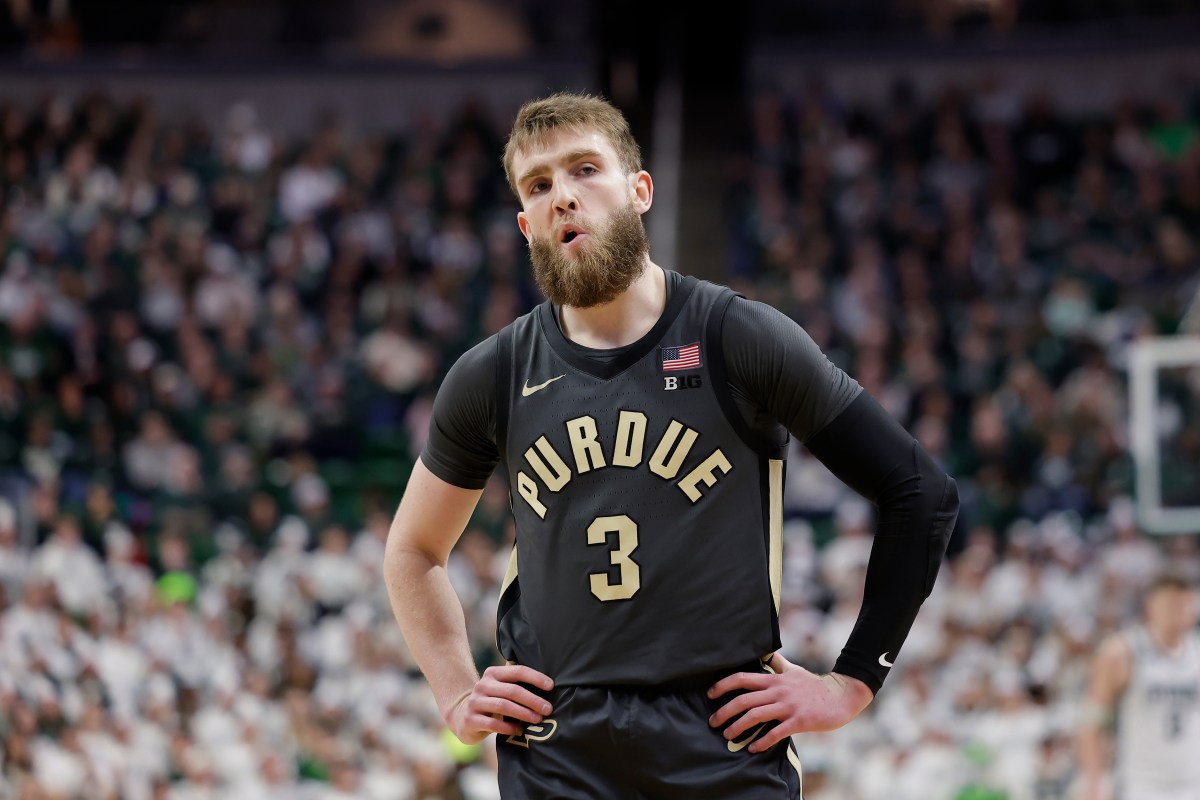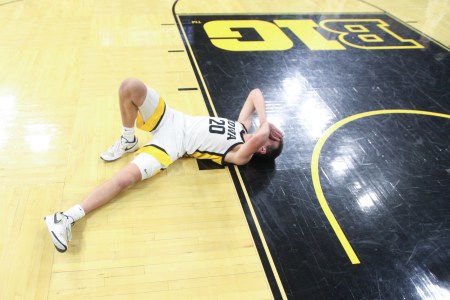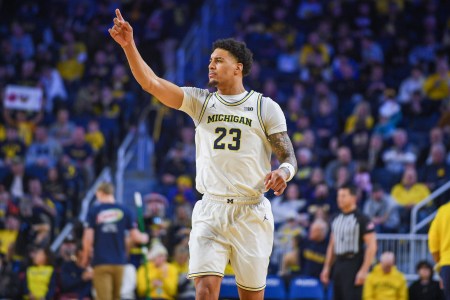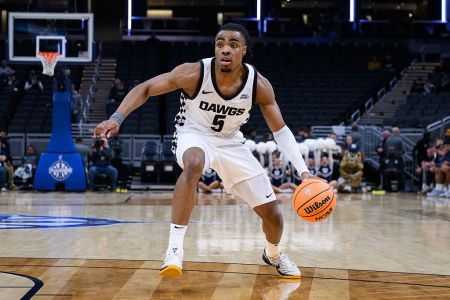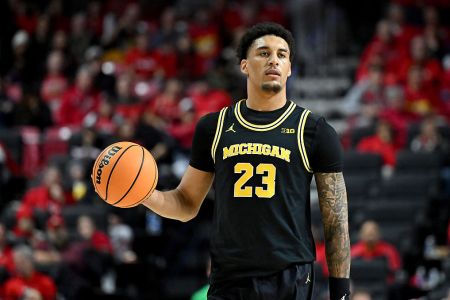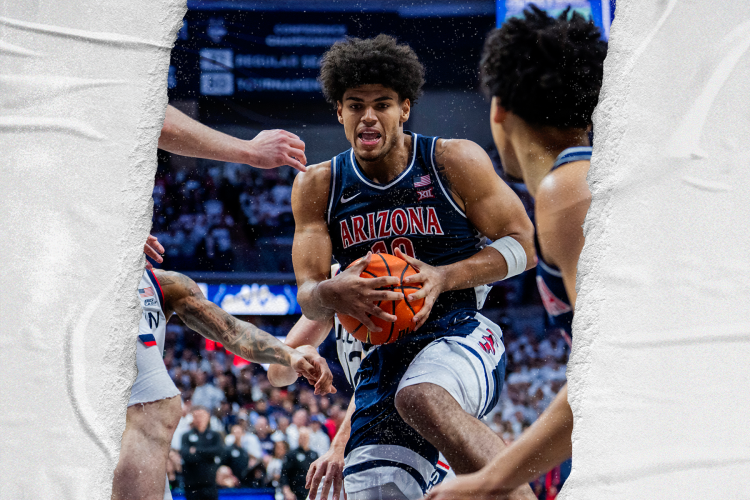With the Big Ten’s regular season over and the conference tournament starting Wednesday in Indianapolis, this is the brief break when everyone reveals their all-league teams.
Rather than follow the beaten path, we’re aiming to have a little more fun here at Hoops HQ. Because there are 13 scholarships per team, we’re going to build a 13-man squad capable of whipping the best from the SEC, Big 12, ACC and Big East in a hypothetical home-and-home round-robin.
Please note: We’re not picking the “best” 13 players. We’re willing to bet all 10 guys on the official All-Big Ten first team don’t show up here. We also don’t care whether a guy is projected to go in the NBA Draft lottery three months from now.
For starters, we’re drafting Tom Izzo to pilot this squad. Not just because he won an 11th Big Ten regular-season title — tying the league record. Not just because he broke Bob Knight’s record for most Big Ten wins. It’s because he did these things while mixing and matching his players’ talents to forge a true 10-man rotation that had answers for every type of opponent. He’ll do the same with this crew. Without further ado:
Point guards
Braden Smith, Purdue: He’s the first player in NCAA history with at least 1,250 points, 700 assists and 500 rebounds before his senior season. Smith, a 6-foot junior, is the only player in Big Ten history — other than some dude named Magic Johnson — to produce at least 450 points, 250 assists, 125 rebounds and 60 steals in a season. He’s also on pace to challenge Bobby Hurley’s NCAA career record of 1,076 assists. So, yeah, the ball will be in his hands after he averaged 16.3 points, 8.8 assists, 4.7 rebounds and 2.3 steals while shooting 39.7 percent on threes. KenPom ranks him as the nation’s No. 6 player.
“In my opinion, he’s the best player in this league,” Purdue coach Matt Painter said Friday night. “They call it the Most Valuable Player, right? He’s pretty valuable. Like, who rebounds like him? Who gets assists like him? Who scores like him? He leads the league in steals or is second in steals. For a guy who had one high-major offer, he’s damn good.
“I think he’ll play 10 years in the NBA. I think he’s fabulous. He affects winning. Sometimes we get away from that.”
Bruce Thornton, Ohio State: When Smith needs a rest, the Big Ten’s two-time champ in assist-to-turnover ratio can take over the point. But the additional beauty of Thornton, a 6-foot-2 junior, is that he’s just as good off the ball, so he and Smith can play together. His KenPom offensive efficiency number for the year is 129.7 — best in the league among “significant contributors” and above — and he averages 17.5 points and 4.5 assists while shooting .499/.426/.846.
Dylan Harper, Rutgers: There’s not a darn thing undeserving about Penn State’s Ace Baldwin and Maryland’s Ja’Kobi Gillespie, but we already have two point guards on the short side. So we’re going with the 6-foot-6 freshman lefty who can get to the basket whenever he wants and has the potential to go off for 30 points in any game — like when Harper went for 36 and 37 on back-to-back nights in Vegas versus Notre Dame and Alabama, respectively. Despite a sprained ankle and a bout with the flu that limited his minutes in a few games and messed with his averages, Harper finished at 19.2 points and 3.9 assists per game while shooting 48.7/34.5/73.8.

Wings
John Tonje, Wisconsin: The 6-foot-5 sixth-year guard’s relatively pedestrian finish — he didn’t hit the 20-point mark in any of the Badgers’ final four games — likely cost him first-team All-American votes. Nonetheless, he is the perfect wing for this squad. He drills three-pointers at a fine rate (37.6 percent), which forces defenders to honor him — then he attacks the basket and draws fouls at an absurd rate. Tonje led the Big Ten in free throws made (185) and attempted(202), and his 91.6 percentage ranked second. Oh, he also averaged 18.9 points and 5.1 rebounds per game.
Jase Richardson, Michigan State: The Spartans’ 10-man rotation makes them so balanced, it’s hard to build an all-star résumé. Richardson, a 6-foot-3 freshman lefthander, showed flashes off the bench during the season’s first 20 games, then it became obvious he was MSU’s X factor once he jumped into the starting lineup Feb. 8. Since then, Michigan State has gone 8-1 and Richardson has averaged 16.9 points and 4.8 rebounds in 30.4 minutes per game while shooting 52.5/37.5/84.6. He’s nearly impossible to guard because he’s equally comfortable slashing to the basket, hitting a floater or shooting a fadeaway. And, of course, you have to respect his rainbow jumper.
Brice Williams, Nebraska: There are a lot of late-game killers on this squad, but this 6-foot-7 sixth-year senior ranks among the best. The Huskers didn’t have enough playmaking or shotmaking options this season, so Williams frequently had to take it upon himself. When he piled up a school-record 43 points in last week’s loss at Ohio State — the second-highest Big Ten total in 13 years — he notched 20 of those during the two overtimes. Williams finished as the Big Ten’s No. 2 scorer at 20.0 points per game while shooting 35.5 on threes and 89.4 at the line.
Dawson Garcia, Minnesota: You want consistency? If this 6-foot-11 senior lefty hadn’t missed a last-second free throw Feb. 4 against Penn State, he would have tied Zach Edey’s mark of eight consecutive 20-point games. You want clutch? Garcia swished a 40-footer at the buzzer Jan. 16 to give the Gophers an 84-81 OT win over Michigan. Beforethat shot, Minnesota was 0-6 in the league. Starting with that shot, Minnesota went 7-7 in Big Ten play. Garcia closed the regular season at 19.1 points and 7.5 rebounds per game and shot 47.2/36.4/77.5 while carrying perhaps the league’s heaviest load, particularly early when the Gophers were particularly shorthanded.
Eric Dailey Jr., UCLA: When we talk about a well-rounded squad capable of matching up with other leagues, this 6-foot-8 sophomore lefthander gives us a “3-and-D” wing who’s unbelievably dedicated to his craft. Per the Los AngelesTimes, Dailey was in the gym Christmas Eve night and again Christmas morning. He’s also a fitting representative of UCLA’s well-rounded team. Dailey’s showing in Saturday’s regular-season finale against USC summed up his impact: Career-high 25 points on 10-of-13 shooting (including 4-of-5 on threes) with 5rebounds, 3steals and ablock. During the regular season, he averaged 12.0 points, 4.2 rebounds and 1.3 blocks in 24.1 minutes per game while shooting 41.0 percent on threes.

Bigs
Trey Kaufman-Renn, Purdue: The whole world knows this 6-foot-9, 260-pound redshirt junior wants to go over his left shoulder – and most post players he faces are taller with longer wingspans. Yet Kaufman-Renn repeatedly finds ways to finish. He closed the regular season as the Big Ten’s No. 3 scorer (at 19.7 points per game) and also was third in field-goal percentage (61.2). He’ll be in our starting lineup to take advantage of his synergy with Braden Smith. KenPom ranks him as the nation’s No. 10 player.
Nate Bittle, Oregon: Highlighted by his career-high 36-point outburst Sunday against Washington, Bittle has averaged 19.7 points, 8.4 rebounds and 3.4 blocks during the Ducks’ seven-game winning streak to close the regular season while shooting .532/.400/.909. The 7-foot senior is one of five finalists for the Kareem Abdul-Jabbar Award that goes to the nation’s best center. He’s a perfect complement alongside Kaufman-Renn on this squad. Bittle’s 3-point ability will draw the other team’s five out of the paint so Smith and TKR can run their games — and he’ll be a Grade A rim protector defensively, which isn’t TKR’s strong suit.
Danny Wolf, Michigan: Of course this 7-foot junior unicorn belongs on this squad. The Yale transfer isn’t perfect — his 103 turnovers rank second in the league — but his absurd versatility at his size makes him the wild card that can take a team’s performance through the roof. Remember when he piled up 21 points, 13 rebounds, 7assists, 6blocks and 2steals at USC? That has happened three times in college basketball in the past 20-plus years. Wolf averages 12.9 points, 9.7 rebounds, 3.7 assists and 1.4 blocks while shooting 50.0 percent from the field and 34.4 from 3-point range. He’s the Big Ten’s lone finalist for the Karl Malone Award as the nation’s best power forward.
Vladislav Goldin, Michigan: Just like we’re going to force other conferences to prepare for the Braden Smith-TKR pick-and-roll game, we’re going to make them figure out how they’re going to stop Area 50-1’s two-man games. Goldin, a FAU transfer, also earned a spot among the Kareem Abdul-Jabbar Award finalists as he ranks sixth nationally in field-goal percentage (64.8). He also averages 16.7 points, 6.7 rebounds and 1.4 blocks while drawing 6.4 fouls per 40 minutes.
Inside the Big Ten: The Race to Make the Big Ten Tourney Heats Up
PLUS: How Oregon’s experience and Bob Knight’s infamous chair fueled wins and other notes from around the league
Derik Queen, Maryland: Heading into last weekend’s games, there were two Division I players who ranked among the top two on their team in points, rebounds, assists, blocks and steals. One was Cooper Flagg. The other was this 6-foot-10 freshman. Queen averages 15.7 points and 9.2 rebounds while shooting 52.6 percent from the field and 75.8 at the line. Like Bittle and Goldin, he’s among the five finalists for the Kareem-Abdul Jabbar Award.
We recognize there are a ton of terrific players not listed above. That’ll happen in an 18-team league where guys have had to play different roles than they might play on a squad like this.
Feel free to share your 13-man crew in the comments below or on Twitter and we’ll discuss.
Big Ten Bubble Watch
Let’s get back to the real games. The Big Ten tournament opens Wednesday in Indianapolis, and the 15 teams heading to Gainbridge Fieldhouse can be divided into three tiers.
With help from BracketMatrix.com, the website that assembles the work of more than 100 bracketologists (including Hoops HQ’s Brad Wachtel) in one place, here’s what’s at stake this week:
TIER 1 (LOCKS)
These eight teams are listed in every bracket and all set for Selection Sunday, no matter what happens this week (with the average seed in parentheses): Michigan State (2), Wisconsin (3), Purdue (4), Maryland (4), Michigan (5), Oregon (5), UCLA (7) and Illinois (7).
TIER 2 (A LITTLE SWEATY)
Indiana (11) and Ohio State (11) have the metrics, as they’re listed on more than 90 percent of brackets, but you don’t want to assume the NCAA Tournament committee thinks the same. Plus, you don’t want to get stuck in a First Four game if you don’t have to, so the Hoosiers and Buckeyes need as many wins as they can get.
TIER 3 (GO ALL THE WAY)
Rutgers, Minnesota, Northwestern, USC and Iowa must win five games in five days to get into the NCAA Tournament — unless the committee really believes in the Wildcats’ KenPom rating of 47th.
Northwestern entered last year’s Big Ten tournament at No. 43 and lost its opener to Wisconsin, yet still earned a No. 9 seed. But last season’s team entered with a 21-11 record. This season’s ’Cats are 16-15.
Five players to watch this week in Indy:
• Illinois 6-foot-8 freshman wing Will Riley has looked every bit an NBA first-round pick over the past 10 games — averaging 16.0 points, 4.6 rebounds and 3.6 assists. “His confidence is through the roof right now,” said Illinois coach Brad Underwood.
• Oregon 6-foot-9 sophomore forward Kwame Evans was listed in preseason mock drafts as a first-round pick, but moved to the bench early this season and almost never played 20 minutes. But he has developed into a huge help to Bittle. Sunday’s 11-point, 11-rebound, 2-block effort means he’s averaging 9.8 points, 8.0 rebounds and 1.8 blocks in 23.3 minutes per game over his past four.
• Maryland 6-foot-4 fifth-year wing Selton Miguel has scored exactly 17 points in five of the Terps’ past eight games while going 23-of-51 from 3-point range(45.1 percent).
• Keep an eye on whether Wisconsin 6-foot-4 fifth-year guard Max Klesmit comes back after missing the past three games with a lower-body injury. His absence affects the Badgers’ defense and limits their backcourt rotation – and doesn’t allow 6-foot senior guard Kamari McGee to be the spark plug off the bench. Also keep an eye on 6-foot-11 sophomore center Nolan Winter. He appeared to strain something in his right arm on a putback jam Saturday against Penn State. The dunk happened with 16 minutes left and he played just 1:12 the rest of the way.
• Guess which player was the highest-scoring freshman in league games? If you said USC 6-foot-4 guard Wesley Yates III, then you’ve watched a bunch of Big Ten Network. Yates averaged 17.0 points on 50.4/47.6/76.5 shooting in his 20 league games, good for 10th overall.
Penn State’s Rhoades on New Big Ten Tourney Format: “Horse- – – -”
While the Big Ten’s decision to limit its postseason tournament to 15 teams made for some terrific drama — who could have projected Sunday’s regular-season finale between Iowa and Nebraska would send one team to the tourney and the other team home? — count Penn State coach Mike Rhoades among those not exactly fans of the Big Ten’s choices.
It was a good point when Rhoades made it after the Nittany Lions’ narrow loss Feb. 26 at Indiana — but looked even more prescient after Penn State closed its season with an 86-75 win at No. 12 Wisconsin.
“I think that’s horse- – – -, to be honest with you,” Rhoades said after the win over the Badgers. “Everybody bangs their chest about the student-athlete experience. And we’re in the Big Ten and we’re keeping three teams out of it?
“And you see how we played today? You know, we had a tough stretch. We had a crazy schedule, too. I don’t think you take away experiences from student-athletes. I think it’s ridiculous. I think it’s not professional. I think the leaders got to do a better job of talking that through.
“But last year, we went to the tournament and we beat a team (Michigan). And if we have one box out, we beat Indiana (a 61-59 loss). Now we win two games. You don’t think we can do that this year if we went?”

